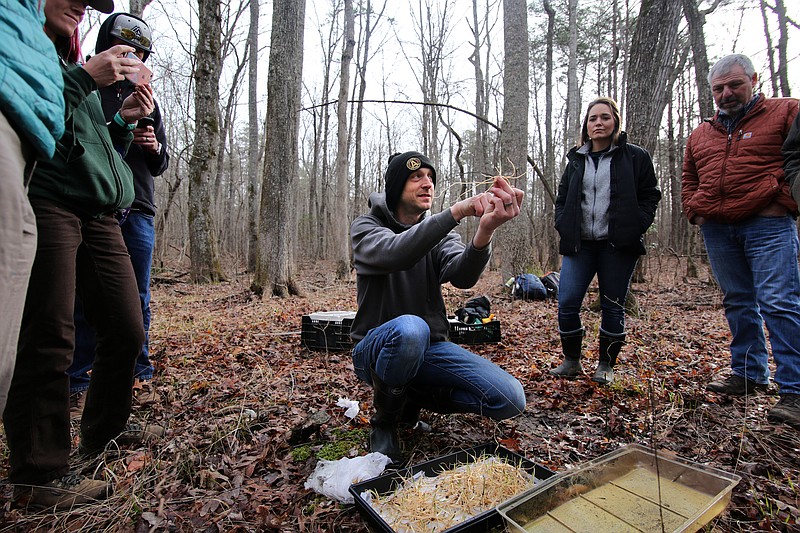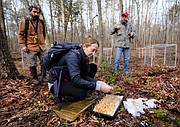SPARTA, Tenn. - University academics, state biologists, federal wildlife personnel, botanists and representatives of the nation's largest public utility met Tuesday deep in the Virgin Falls Pocket Wilderness to introduce a threatened plant native to the Cumberland Plateau into new habitat.
The ongoing collaboration aims to help save a population of federally threatened white fringeless orchid and provide University of Tennessee at Chattanooga researchers a chance to study different methods to help regrow the federally listed species.
The orchids are primarily found in small patches of less than 100 plants and are known to grow only in six Southeastern states. Tennessee's Cumberland Plateau serves as that area's epicenter. They are extremely difficult to grow, as they require fertilization from a separate fungus - only about one in 1 million seeds fertilize. Those that do face threats from changes in habitat, land use and animals. Healthy populations have been found in both heavily shaded, dense forest areas and open corridors with ample sunlight, which is unusual for plants.
This particular population would have been killed when an old transmission line was removed near Spencer, Tennessee. The move will allow the area to return to its natural wooded habitat but will be a detriment to some plants, such as the orchids, that have moved into the habitat in the decades since the line was installed.
The utility company found the plant while conducting an environmental assessment and was required to notify the U.S. Fish and Wildlife Service. The groups hatched the plan to move them to the new habitat with the help of outside agencies.
The plan involved transporting the orchids to Atlanta Botanical Garden and its orchid expert, Matt Richards; computer modeling by the Tennessee Department of Environment and Conservation; visits to potential sites; the help of outside botanists; coordination with the Tennessee Wildlife Resources Agency, which maintains the land; and lots of collaboration.
TDEC's computer modeling helped find a new location in Falls Pocket Wilderness between Sparta and Crossville - north of Pikeville and Fall Creek Falls State Park.
Biologists didn't want to plant the population in a habitat with orchids, so they searched for other areas with similar features: hydrology to support growth, sphagnum moss and other similarities. They also wanted to replant the population on public land so it could be monitored and cared for.
UTC researchers and TWRA personnel previously marked off four areas to replant the species. On Tuesday, the group of about 10 returned to plant the orchids in their new home.
The forested wetland along the Bridgestone-Firestone Centennial Wilderness offers areas with a variety of sunlight exposure, which will allow researchers to observe whether the individual plants are able to adjust to different amounts of light exposure or whether there is a genetic trait that accounts for the wide range.
Cages of PVC pipe and chicken wire were placed around a select group to confirm whether deer are regularly eating the plants. Some of the cages are designed to keep all animals out. Others have small openings cut near the ground to rule out other small animals, such as rabbits. Some are surrounded by PVC cages with no chicken wire to determine whether the material in itself has an effect on the plants that could hinder the experiment. The rest have been left open to grow naturally.
The team planted between 300 and 400 white fringeless orchids. More seeds are being grown and cared for in Atlanta until they can be introduced.
Researchers hope the new habitat will give them plenty of space to study different environments.
"I think what we've been able to learn and what we will learn from a research standpoint will be of value," Tennessee Valley Authority botanist Adam Dattilo said. "I just can't express enough how important it is to have most conservation entities in the state working on this project."
UTC associate professor Jennifer Boyd and graduate student Savanna Wooten are leading the study about two distinct aspects that could be crucial in replenishing the population: how light affects the orchid and whether deer are a main cause of the population decline.
"I'm really interested in physiology and how that affects growth," Boyd said. "I want to provide them with the information they need while also addressing questions that are interesting to me."
Geoff Call, U.S. Fish and Wildlife Service endangered species recovery coordinator, and other wildlife service employees worked to get the species federally listed in 2016 and quickly became involved with this project. The group is working on a species recovery plan that is expected to be released for public comment later this year.
Call praised Tuesday's efforts.
"All of this goes to show you can't do good conservation work by yourself," he said.
Contact staff writer Mark Pace at mpace@timesfreepress.com or 423-757-6659. Follow him on Twitter @themarkpace and on Facebook at ChattanoogaOutdoorsTFP.

